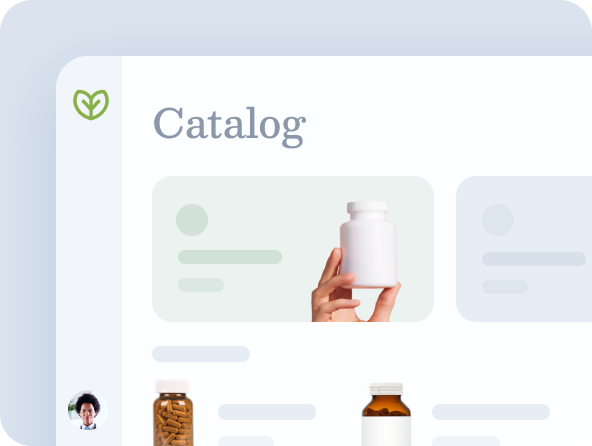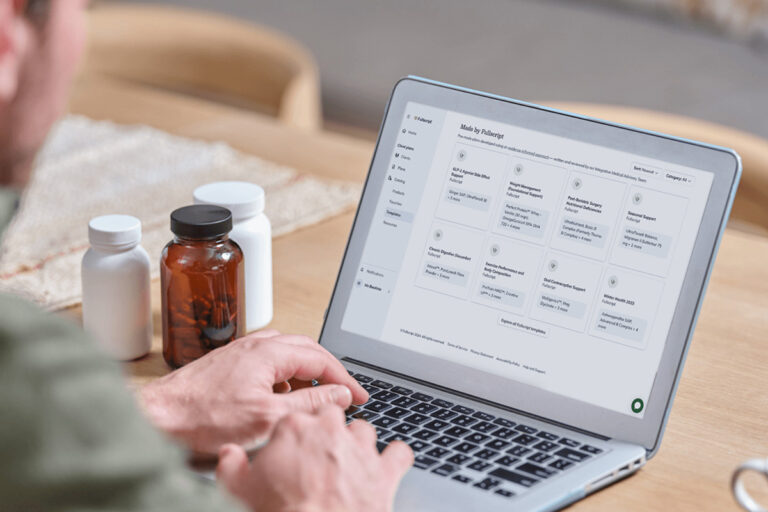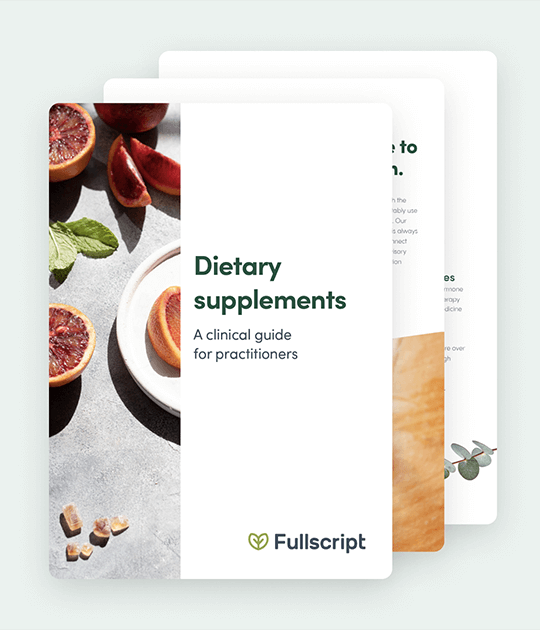What Is SIBO?
SIBO, or small intestinal bacterial overgrowth, is an accumulation of bacteria in the small intestine. The gastrointestinal tract hosts a multitude of bacteria, but when these bacteria proliferate abnormally in the small bowel, it can lead to digestive and absorptive issues. (5)
Unlike the large intestine, which is designed to accommodate a high bacterial load, the small bowel should contain comparatively fewer bacteria. When the small bowel becomes overgrown with bacteria, it can damage the intestinal mucosa, interfere with normal digestion, and lead to a variety of symptoms.
SIBO Elemental Diet
The elemental diet, which involves consuming easily predigested micronutrients, is often used temporarily to help address SIBO. (1) Read on to learn more about the clinical applications of implementing the elemental diet for SIBO.
Ready to start delivering better patient care?

Symptoms of SIBO
SIBO often manifests with symptoms resembling those of irritable bowel syndrome (IBS). Research indicates that SIBO is present in as many as 78% of individuals diagnosed with IBS, suggesting a possible connection between the two conditions. (5)
Typical gastrointestinal symptoms associated with SIBO include:
- Abdominal discomfort
- Belching
- Bloating
- Constipation
- Diarrhea
- Gas
- Heartburn
- Nausea (5)
Moreover, SIBO may be linked to several other conditions beyond IBS. SIBO may be an underlying factor or arise as a consequence of another pre-existing condition. Celiac disease, inflammatory bowel disease (IBD), and Ehlers-Danlos syndrome are examples of some of the many conditions that SIBO may be associated with. (7)
How to Test for SIBO
The presence of SIBO can be detected using breath tests. SIBO breath testing involves the measurement of hydrogen (H2), methane (CH4), and/or hydrogen sulfide (H2S) gases produced by bacteria residing in the intestines. During the test, the levels of these gases are recorded over a period of two or three hours, depending on the laboratory used. (1)
To prepare for the test, patients follow a simple one-day preparatory diet that excludes specific foods that are known to feed intestinal bacteria. (1)
On the day of testing, patients first provide a baseline breath sample. Then they consume a sugar solution (generally lactulose), which serves as a food source for the bacteria. (1)
Subsequent breath samples are collected every 15 or 20 minutes over the next few hours. If bacteria are present to consume the lactulose, hydrogen, methane, or hydrogen sulfide gases (or a combination of any of these) are produced and will be detected.

Interpreting SIBO Breath Test Results
Interpreting SIBO breath test results typically involves analyzing the levels of hydrogen, methane, and/or hydrogen sulfide gases measured during the test. If gas levels rise above a certain threshold during a specified timeframe, you can presume that bacterial overgrowth exists. (4)
Additionally, other factors such as symptoms, clinical history, and additional diagnostic testing are considered alongside the breath test results to provide a comprehensive evaluation and guide treatment decisions. (4)
How to Treat SIBO: The Elemental Diet
In recent years, the use of the elemental diet as a treatment for SIBO has gained significant attention, thanks to the contributions of Dr. Allison Siebecker, ND, and Dr. Mark Pimentel, MD, amongst others. Research and clinical experience have both demonstrated the remarkable effectiveness of the elemental diet in eradicating SIBO. (8)
Treatment with the elemental diet boasts an impressive success rate of eliminating bacterial overgrowth, as shown by normalization of the lactulose breath test. In one study, a treatment time of two weeks was 80% effective and three weeks was 85% effective in eradicating bacterial overgrowth. Additionally, 65% of people experienced an improvement in their IBS symptoms.
This treatment approach is considered highly effective and surpasses the success rates of other SIBO treatments by a wide margin.
What Is the Elemental Diet?
Let’s begin by understanding the concept of “elemental.” According to the Merriam-Webster Dictionary, elemental refers to something that is simple, uncomplicated, and fundamental. (3)
On an elemental diet, the primary source of nutrition comes from specially designed elemental shake formulas. These formulas contain the simplest forms of all the necessary nutrients: amino acids, simple sugars, fats, vitamins, and minerals. They are designed to be easily absorbed and require minimal digestive effort. (9)
Elemental shake formulas typically come in a powdered form, which are mixed with water to create a liquid shake. During an exclusive elemental diet, no solid food is consumed. The purpose is to give the digestive system a break and allow it to heal. (6)(9)
It’s important to note that the elemental diet is typically used as a short-term therapeutic intervention under the guidance of a knowledgeable healthcare professional. The specific duration and protocol may vary based on individual needs and the condition being treated.
Why Is the Elemental Diet Effective at Treating SIBO?
The “predigested” nutrients in elemental shake formulas are absorbed very rapidly in the small intestine. As a result, you provide the person with nutrients that are not fermentable by the bacteria in the gut, reducing the bacterial overgrowth and the symptoms associated with it. In essence, you’re feeding the person while starving the bacteria. (10)
While certain bacterial overgrowths may be eradicated by herbs or antibiotics, in theory, starvation affects all bacteria—causing them to die off after a period of two to three weeks without solid food consumption. (2)
Elemental Diet Versus Antibiotics or Herbal Antimicrobials for SIBO
A course of antibiotics or herbal antimicrobials for SIBO typically reduces bacterial overgrowth by approximately 30 ppm over a two to three week period. In our clinical practice, we’ve witnessed, on dozens of occasions, a decrease of 100 ppm (or more) in bacterial overgrowth with a two- to three-week elemental diet treatment course!
Additionally, we’ve found an elemental diet to be highly effective with all three types of bacterial overgrowths––hydrogen, methane, and hydrogen sulfide.
Choosing an elemental diet can:
- Be used in resistant SIBO cases when the bacterial overgrowth has shown resistance to the antibiotics or herbal antimicrobials
- Help a person avoid multiple rounds of antibiotics or herbal antimicrobials
- Reduce treatment time significantly (8)
As clinicians, we’ve always been interested in treatments that demonstrate a great amount of benefit with a low risk of harm—and in our opinion, this is certainly true for elemental diets.
While there are some challenges that arise for most people throughout the elemental diet process, they are generally easily overcome if one knows to expect them and how to address them. These side effects may include symptoms of bacterial die-off or energy and blood sugar fluctuations, for example.
Can SIBO Come Back After Using the Elemental Diet Protocol?
After using an elemental diet to treat SIBO, ideally, you would want to repeat a SIBO breath test to ensure that the bacterial overgrowth was fully eradicated.
It’s important to understand that bacterial eradication alone does not always correct the underlying cause(s) of SIBO, and without preventative measures, bacteria can repopulate in the small intestine and SIBO can recur. (11)
All successful SIBO treatment plans should be followed by preventative measures that encourage gastrointestinal motility and support overall digestive health.
The Bottom Line: The Elemental Diet Is an Effective Treatment for SIBO
The elemental diet has been shown to be an effective treatment option for individuals experiencing SIBO. If you’re a practitioner, login to your Fullscript account today to gain access to various products to support your patients following an elemental diet.





